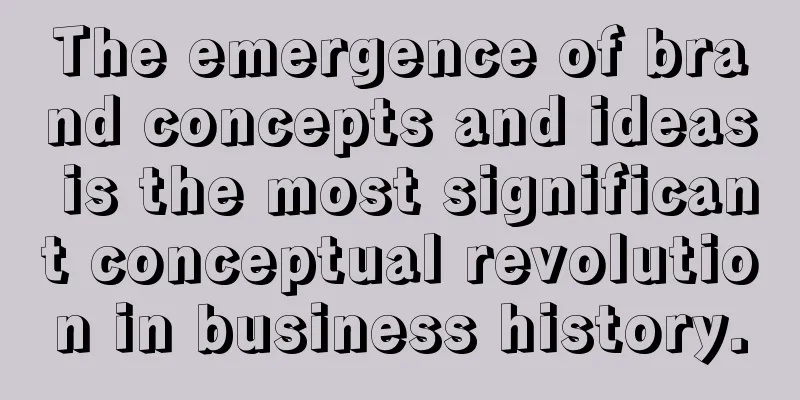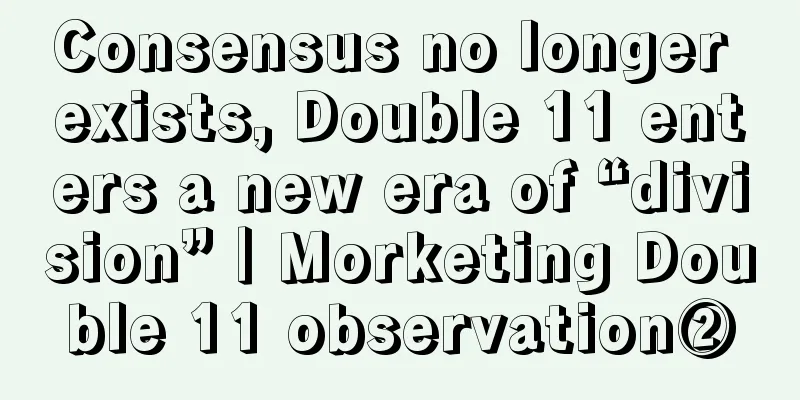The emergence of brand concepts and ideas is the most significant conceptual revolution in business history.

1. The formation of brand concept and brand ideaThis is the most significant conceptual revolution in the history of business. The emergence of brand concepts and brand theories has separated brands from products. Since then, the business world has clearly recognized the difference between brands and products. This conceptual revolution has directly given rise to modern business and marketing. Brands originate from categories/products, but are higher than products. When brands are freed from the constraints and restrictions of products, brand ideas have also flourished like mushrooms after rain. If Gardner and Levy's "Products and Brands" published in the "Harvard Business Review" in 1955 is regarded as the foundation of brand concepts and brand theories, then in the more than 60 years since then, brand theories have continued to evolve and surpass themselves. 2. The first self-transcendence of brand conceptThe first self-transcendence came from the brand rising from marketing promotion to the strategic level. Brand is no longer a tool for promotion and marketing, but a strategic competitiveness of the enterprise, and the most valuable intangible asset of the enterprise. Its landmark event was the publication of Aaker's "Brand Equity Trilogy" and Keller's "Strategic Brand Management" in the 1990s. 3. The Second Self-Transcendence of Brand ConceptThe second time comes from the shift from focusing on the brand itself to focusing on the relationship between the brand and consumers. In the past, brands were defined based on the brand itself, but at this stage, brands are defined based on the relationship between the brand and consumers. 4. The third self-transcendence of brand conceptThe third time came in the past 10 years, with the rise of fragmented media, the rapid evolution of technology, the improvement of the supply chain, and many brands’ emphasis on the relationship between brands and users. This has caused brands to occupy a large amount of users’ and consumers’ time in order to “build relationships” with customers. Text messages, phone calls, public accounts, private domains, memberships, etc., all these “relationship” means have brought great trouble to users. With the blessing of big data and artificial intelligence, this kind of “relationship” has become a means of “doing evil”. Big data is not uncommon. The concept of brand must be re-iterated and regressed: the essence of an enterprise is a business machine. Products, marketing, supply chain, management, etc. are all parts of this business machine, and the brand is the finished product of this business machine. The emphasis of the enterprise on the relationship with the user is still on how to continue to make customers spend money. What the brand needs to do more is to package everything into the brand and deliver it to the user. 5. Brand Building in the Traditional EraIt comes from the packaging of objects, such as giving the product a symbol, a trademark, or a name; packaging a selling point, a positioning; packaging an image, giving the product an attitude, personality, and emotion, so that the product generates a premium and wins user recognition. Brand building in the digital age comes from the operation of people. The various concepts and marketing methods we often talk about today, such as scenarios, communities, interactions, fans, private domain traffic, and growth hackers, all start from how to connect with users and establish relationships. Brands start from products, but are defined by users. User image determines brand image, and customer cognitive value determines brand value. Understanding the brand-consumer relationship can help us grasp the essence of the brand. The formation of brand encapsulation theory directly transcends single-point thinking to think about brands, and coordinates brand strategies from the perspective of the overall situation of the enterprise. 6. Schultz's Integrated Marketing Communication TheoryMcCarthy, an American commercial marketing practitioner, once proposed that a complete marketing consists of four elements, namely Product, Price, Place, and Promotion. These four marketing elements are referred to as the 4Ps of marketing. After the 4Ps of marketing were proposed, although some people later added N Ps to the end, making it 6P, 8P, 12P, etc., no matter how many Ps there are, the four core elements of marketing have never changed. Professor Schultz, who graduated from Northwestern University in the United States with Kotler and is world-renowned, mentioned in his important book "Integrated Marketing Communications": With the changes in the market environment, the core of marketing is also changing. In the new environment, 4P is outdated. The thinking of brand marketing should change from marketing 4P to marketing 4C, that is, demand, value, convenience, and communication. Marketing 4C is reasonable from the perspective of academic logic. That is, you should not only consider what products to make, but also consider what needs consumers have from their perspective; do not only consider what price to sell to consumers, but also consider what value to bring to consumers; do not consider what channels to sell products and services to consumers, but what methods can make consumers more convenient; do not always think about how to spread, promote and promote, but do everything possible to reason with consumers and communicate. But if companies really follow Schultz's way of playing from organization to operation, no company will be able to play well. Using the term used by Nobel Prize winner in Economics Coase to refer to impractical economics as "blackboard economics", Schultz's 4C marketing can be called "blackboard marketing". In the more than 30 years since Schultz's "Integrated Marketing Communications" was published and became a popular book around the world, no company has achieved success in brand marketing by relying on this set of theoretical guidance. As time goes by, Schultz's integrated marketing communication theory has also been slowly forgotten. 7. Products are an important strategy for enterprise developmentThe 4Ps of Marketing have withstood the test of time. In the past 60 years of business practice, countless companies have proven their theoretical foundation and practicability. Products have become an important strategy for corporate development. For companies like Apple, every success is supported by a successful product. The launch of the Apple Music Player allowed Steve Jobs to confidently announce to the world that he had made Apple successful again after his return; the launch of the iPhone allowed Apple to complete the iterative revolution from feature phones to smartphones; and the launch of the iPhone tablet allowed Apple to define the tablet computer. Products are about product structure, and each product has its own role and strategic mission; products also need to be launched in the right order. Price means the choice of the enterprise's marketing model , the definition of product value, and the logic of interest distribution for each participant. Channels are the "political system" of the enterprise, which is the sum of the entire process of the product from the producer to the consumer. The purpose of promotion is to make the company's products and services widely known. 8. Branding is necessarySince enterprises have completed a complete marketing campaign through the four steps of product, price, channel and promotion in the process of interacting with consumers, why do we need to separate another dimension "brand" from marketing? Is brand redundant? This question does not need to be discussed in too much space. Enterprises of a certain scale will mention brand in their daily meetings, which is enough to show the importance of brand. If an enterprise does not mention brand, it will not be able to have in-depth and complete communication with stakeholders. What does this mean? 9. Brand PowerLet's restore the dialogue scene in the commercial field: When the company's sales staff sells products to consumers, the sales staff will say: "Try our products. Our products are delicious. We are an old brand that has been in business for many years and are trustworthy." When consumers or channel dealers ask why your products are so expensive, the company's marketing staff will say: "We are branded goods, which are different from the products of companies without brands." When the marketing staff is looking for channel dealers, they will say: "Our brand is worth your doing. Our brand power is very strong. You can make a profit by doing our brand." If a company must hold a promotion event in a high-end office building, such as Shanghai Center, or the company must move into a high-end office building, and the company's products must be placed in high-end shopping malls, then the investment promotion personnel in these places will definitely care whether you are a brand. Without a brand, you will not be allowed to do it even if you are paid. 10. Build a good brand and complete the enterpriseWhy do companies always mention brands when they conduct business in the market? If we compare a company to a business machine, then the marketing 4Ps and other elements are like the parts of the business machine. Only when these parts are "packaged" in the brand can the business machine be complete. A company that has not truly established a brand is like a machine that has not been "packaged". It cannot be sold at a high price, let alone its value. Only by building a good brand can a company be a complete business machine. The various elements and parts of Coca-Cola have been packaged, so Coca-Cola has been sold for more than 130 years. Procter & Gamble, Unilever, McDonald's, Apple, and Tesla have been "packaged", so they can sell well all over the world. 11. Branding is a mustWithout a brand, the "business machine" of an enterprise is only a semi-finished product. A brand is to package the various elements and parts of the business machine of an enterprise into a "finished product". This means that if an enterprise wants to add value to its products and services, branding is not an "option" but a must. It is extremely important to master the underlying logic of packaging the "business machine" of an enterprise. 12. Principles of Brand InnovationTo package the various elements and “parts” of an enterprise into a complete brand, it is necessary to master the “brand packaging principle”, that is, the “brand innovation principle”. Brand is the "cognitive product" delivered by the company to its customers; innovation is the method and behavior of utilizing existing and integrable knowledge and resources, proposing insights that are different from conventional ideas, making improvements and innovations based on the needs of corporate development, and obtaining positive results; principles are the most basic laws and truths with universal significance. The complete definition of the brand innovation principle is: in the process of delivering cognitive products to customers, enterprises use existing and integrable knowledge and resources to propose insights that are different from conventional ideas, improve and innovate in order to meet the needs of enterprise development, and obtain methods and behaviors that have positive effects. At the same time, they follow the laws and principles of universal significance. 13. The First Principle of InnovationThe first innovation principle that brands follow: define the brand type first, then start branding. Most companies and professionals are aware that branding involves exploring the brand's core value, establishing the brand image, shaping the brand's personality, designing the brand symbol, determining the brand positioning, and creating the brand's proposition. However, most professionals are not aware that before branding, the most important thing is to define the brand type first, and then start branding, because different brand types have completely different focuses on branding. Brands can be divided into three types: luxury product brands, fashion product brands, and high-end product brands. To build a luxury brand, we need to talk about dreams, because luxury brands represent the permanent self-differentiation of social classes. We can look at Dior, Hermès, and Cartier. To build a fashion product brand, we need to talk about temptation. Fashion products are tribal, imitative, and short-lived. The Lun Boy brand in the recent Tangshan beating incident is an obvious example. The fashion products created by the ZARA brand are also short-lived. To build a high-end product brand, we need to talk about realism. High-end brands need to emphasize performance, price, rational data and comparability. 14. Article 2 Innovation PrincipleThe second innovation principle followed by brands: consumer motivation comes first, and brand awareness comes later. When building a brand, we all hope to establish a brand awareness in the end. For example, Apple's products give people the perception that they are high-end, well-designed, and easy to use. When we are doing brand innovation, we must understand that brand awareness is only the result achieved after brand innovation. When a company starts to build a brand, it is not the case that it says what kind of awareness it wants to establish in the minds of consumers. In that way, the company basically cannot achieve its goals. Humans are the only species in the world with "self-awareness". Because we have self-awareness, we have motivation for everything we do. When people engage in consumption behavior, they generally have five consumption motivations, which are: habits, norms, values, emotions, and identity. Beverage brands like Red Bull and Wanglaoji target consumer motivation based on habit. Red Bull says: "When you are sleepy and tired, drink Red Bull"; Wanglaoji says: "If you are afraid of getting a sore throat, drink Wanglaoji." The consumer motivation you hope to create is that the reason why consumers like your brand is that when they are in a certain scenario, they will subconsciously think of using your product. Brands like Pampers and Biostime, which target infants and young children as their core consumer group, focus on standardization. Smart mothers use Pampers and Biostime, so their babies get sick less often and mothers worry less about these things. They lock in habitual consumption motivations and create a consumer perception that the reason consumers want their brands is to avoid and eliminate an inner conflict that goes against their norms and values. The national liquor Moutai and the national secret formula of Yunnan Baiyao focus on value. The consumer perception they hope to create is that consumers believe in their brands because they believe that their products can bring greater value than their competitors. The main theme of Haagen-Dazs's "If You Love Her, Treat Her to Haagen-Dazs ice cream" is emotional motivation. The reason why consumers like Haagen-Dazs is that Haagen-Dazs ice cream inspires certain emotions in their hearts. The reason why brands such as Rolls-Royce and Hermes are popular among consumers is that they feel more noble when using these products and it can better demonstrate their status. Consumers will have different consumption motivations and adopt different consumer behaviors in different consumption scenarios. They will establish their own brand motivation circle under the five motivations of habit, norm, value, emotion and identity. Different brands will appear in their minds under different scenarios and motivations, and purchase behaviors will be generated under the drive of cognition. 15. The third innovation principleThe third innovation principle followed by brands: All brands have prototypes. Return to the cultural matrix, find the brand prototype, and then reshape the brand image. Each of us pursues the balance of four factors in our life: sense of belonging vs. independence; stability vs. desire for conquest. If these two tracks become horizontal and vertical lines and become a coordinate, they will constitute the four major motivations on the two tracks. The ultimate essence of the brand is to satisfy the motivation of human nature. These four major motivations are: establishing order, yearning for freedom, rejecting loneliness, and self-achievement. The archetypal motivation of the brand that establishes order is stability, under which three archetypal images are extended, namely, the caregiver, the creator, and the ruler; the archetypal motivation of the brand that yearns for freedom is independence, from which three archetypal images are extended, namely, the naive, the explorer, and the wise man; the archetypal motivation of the brand that refuses loneliness is belonging, from which three archetypal images are extended, namely, the mortal, the lover, and the clown; the archetypal motivation of the brand that achieves self-achievement is the desire to conquer, from which three archetypal images are extended, namely, the hero, the rebel, and the magician. With the brand archetype, the brand image of the enterprise can be shaped through creativity to touch people's hearts. Take Nike, the most familiar sports brand, for example. Nike's brand archetype is a self-achievement brand. Its archetype motivation is the desire to conquer. Its archetype image is a hero. Heroes don't want to be powerless, incompetent, or useless, so they want to gain a sense of achievement. To gain a sense of achievement, they must surpass themselves, do brave actions, and break the rules. So Nike shouts "just do it." And it continues to shape its brand image around the brand archetype. 16. Article 4 Innovation PrincipleThe fourth innovation principle followed by brands: first confirm consumers’ existing cognition, then develop brand positioning. The essence of marketing is to take advantage of human memory. Human recorded history has exceeded 5,000 years, and human evolution and development to today have gone through millions of years. In our memory, many innate cognitions are formed due to factors such as genes, habits, and education. To do brand positioning, we must determine whether the direction of our positioning is already cognized by consumers, and privatize the existing cognition to our own brand. In this way, the cost of trial and error is low, and it can greatly save consumers' costs. Take the brands that everyone is familiar with as an example. In China, people have always believed that getting angry is a problem, so there is a market for beverages that prevent getting angry. Because of this strong existing cognition, there is the saying "If you are afraid of getting angry, drink Wanglaoji". Consumers believe that safe driving is a problem, so there are safe cars from Volvo Cars. Consumers believe that drinking sugary drinks will make you fat, so there is the 0 sugar, 0 calories, 0 fat Yuanqi Forest sparkling water. 17. Brand is the "finished product" of the enterpriseAn enterprise is a "business machine" and various elements are just the "parts" of the machine. Only the brand is the "finished product" of the business machine. No matter how the concept of brand changes, enterprises must master the brand packaging technology. Author: Liu Yichun Source: WeChat public account "Liu Yichun's Brand Business Innovation (ID: shangyeyiguohui)" |
<<: Learn to think big first, then start small
>>: How can B2B companies build good IP?
Recommend
How long does it take for the goods from Korea Gmarket to arrive? How long does it take for direct shipping to China?
With the rise of global cross-border e-commerce, m...
How do Internet newcomers choose careers, industries, and companies (Part 2)
Continuing from the previous article, in this arti...
Five ways to open a window display on Douyin
This article explains five methods of opening a wi...
The bloggers who left their jobs and couldn't squeeze through the single-plank bridge have collectively returned to work
Resigned bloggers have chosen to return to the wor...
Paying for knowledge is compound interest, but it should not be huge profits!
Knowledge payment has been very popular in recent ...
What do companies need to provide when receiving foreign exchange? What is the foreign exchange operation process?
As the pace of globalization accelerates, more and...
Is Wish children's clothing easy to sell? How can I make it sell well?
Every family is willing to spend money on their ch...
JD.com's "10 billion subsidies", merchant strategy exposed
Recently, JD.com is preparing to upgrade its "...
How to deal with out-of-stock orders on Lazada stores? What happens if Lazada delivery is overdue?
Lazada delivery is one of the important links in s...
Rethinking Women in Business
On the past Women's Day, PROYA's marketing...
The single-game GMV beats Brother Yang. What are the killer features of the dark horse anchor Mi Daodao?
As more and more people start to join the live bro...
Is it tiring for girls to work on Amazon operations? Is there a future for them?
On Amazon, you can choose to open your own store, ...
Saying goodbye to the free era, is Xianyu anxious to make money?
Recently, Xianyu announced that it would implement...
Seven thoughts on branding in marketing
Many brands actually lack consistency in the proce...
2500-word analysis | The development process of ordinary people becoming personal IP
How can ordinary people become personal IPs? How d...









